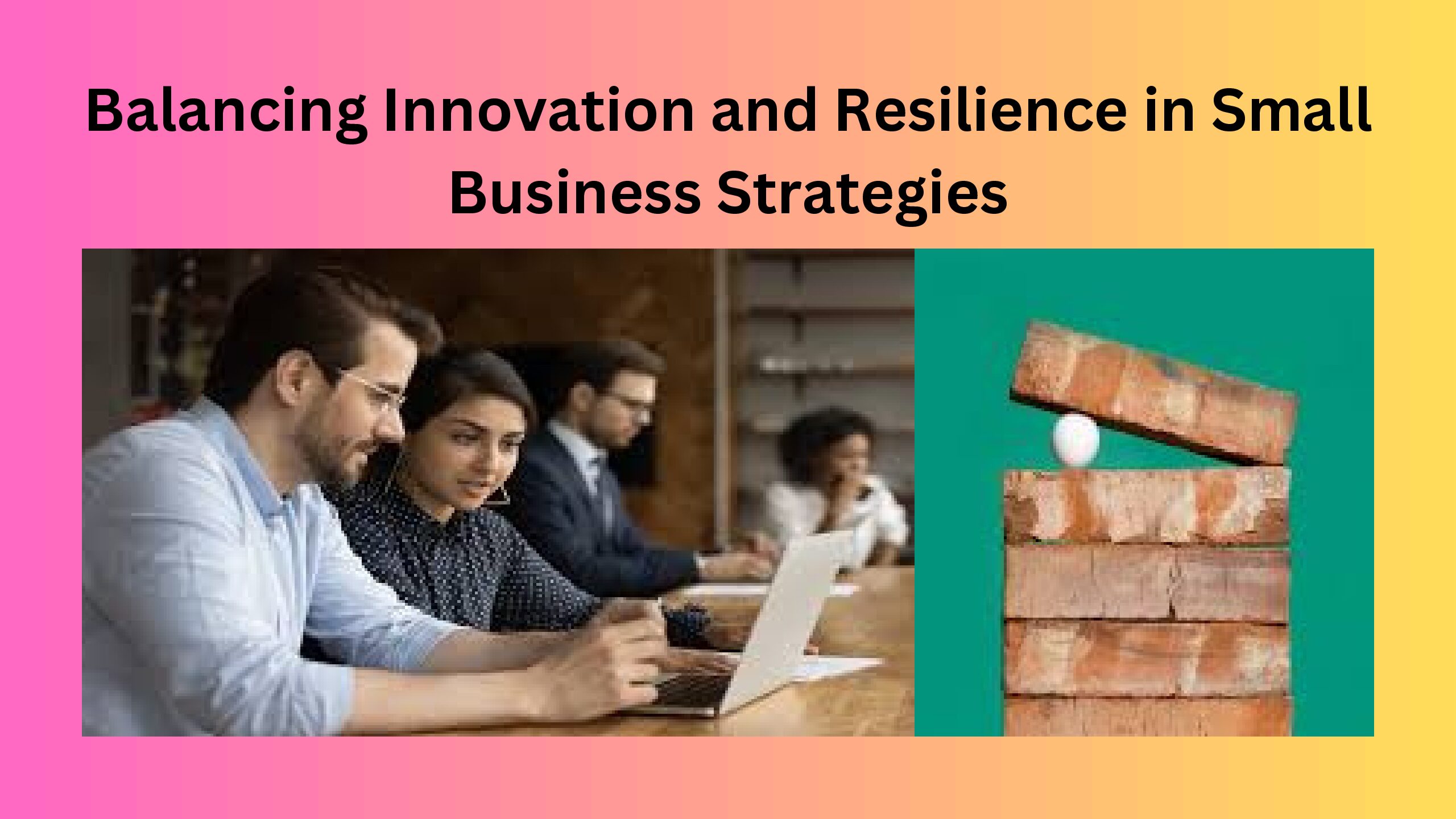In the tumultuous business world where everyone whether small or large, is competing to be ahead of the pack two elements have been identified as crucial for small enterprises in achieving success: innovation and resiliency.
The vitality of every business particularly small ones is their capacity to continuously change, innovate and develop new services, products, or methods.
Innovation is a key factor. But the unpredictable nature of the business environment particularly in the current rapidly evolving environment, implies that simply innovating won’t suffice. Resilience, also known as the ability to bounce back and withstand obstacles, setbacks and changes, is vital.
The ever-changing nature of the business world today poses difficulties for small-scale companies. They often face the lack of resources, intense competition, and continually changing customer expectations. When faced with such adversities, sticking to a single strategy could be fatal.
This blog dives into the intricate dance of the two. Innovation and resiliency. Our goal? to explore strategies that will allow small companies to find the right balance and guarantee not only survival, but sustainable growth and prosperity in a world that is waiting for no one.
The importance of innovation and Resilience
Resilience and innovation are two key elements to the survival of small firms in today’s crowded market. Both of these factors are crucial in helping small businesses expand, adapt and flourish in a changing business environment.
The importance of innovation for small-sized businesses
Innovation is the capacity to develop and implement new concepts, products, services or processes that create value and satisfy the evolving demands of clients. For small-sized companies, innovation is crucial to remain current, attracting customers and distinguishing oneself from the competition.
By constantly innovating small-scale companies can remain ahead of the pack and anticipate market trends and adapt quickly to changing requirements of customers. They are more flexible and adaptable which is vital to long-term success.
The importance of resilience for small-sized businesses
Resilience is the capacity to endure and bounce back from setbacks or challenges or interruptions. In the face of challenges resilient businesses are able to adapt to bounce back, recover, and even discover new opportunities.
Resilience can help small businesses thrive in difficult times, like recessions in the economy or sudden incidents like natural disasters, or pandemics that are global in scope. With the ability to be resilient, small businesses are able to manage risks, keep security, and carry on operations regardless of external stressors.
A Few Examples
- Canva began as an website-based tool for design, Canva has consistently innovated providing new tools and features to its users. Its durability is evident in its dedication to a user-friendly interface and its ability to keep ahead of its competitors.
- Mailchimp was initially the name of an email-marketing platform Mailchimp has continuously added new features and diversified its services. Despite the rise of other platforms for marketing, Mailchimp has remained resilient by constantly developing and expanding its offerings without sacrificing its user-friendly interface.
The Dichotomy of Innovation against. Resilience
Conflict between the need to prioritize innovation and resiliency
The conflict between resilience and innovation is a challenging issue that small-scale businesses have to confront. On the one the other hand, innovation is vital to grow and remain relevant in a fast-changing market. However it is vital to have resilience to survive and overcome obstacles. The balance between these two aspects isn’t easy, since too much focus on one aspect could cause you to overlook the other.
One possible conflict between resilience and innovation is the way resources are allocated. Smaller businesses usually have small resources and manpower, so investing too much in innovation could expose them to risk in times of crises.
A company, for instance, who invests its entire resources in the development of new products but does not build a solid financial base may be unable to withstand economic declines. However one that is focused only on resilience could be behind in its competition and be unable to adjust to changes in customer demands. Real-world scenarios where priority is only one element.
Prioritizing Innovation over Resilience:
The scenario: Sarah owns a small cafe. Inspiring by a need to be noticed and draw new customers, she continuously introduces new drinks and food items to her menu. She also revamps the interior frequently and is heavily investing in the latest technology to process orders and pay.
Challenges:
- Inconsistency: Continuously changing the menu can be confusing and displease customers who visit for their favorite dishes or drinks.
- High Operating costs: Investing in regular changes and the most recent technology solutions could strain her budget.
- Insufficient Crisis Management Focusing predominantly on innovations, Sarah might not have an emergency plan or emergency savings. In the event of an unexpected downturn such as a pandemic or natural disaster her company may not be able to withstand the shock.
Prioritizing Resilience over Innovation:
Situation: Alex runs a family store that’s been running for a long time. It’s always been his main objective to ensure that the company can withstand any and every challenge. He’s accumulated a substantial reserve fund for emergencies, has kept operational expenses low by avoiding technological updates, and sticks with the proven and reliable inventory that his customers love.
Challenges:
- Stagnation: Without updating his inventory or adding new technology, Alex might miss out on reaching a younger demographic or reaping the benefits of more efficient operations that technology can provide.
- Increased Competition: As rivals come up with new solutions, such as reading clubs, online shopping or events in stores, Alex’s store could see the loss of the number of customers it serves.
- In the past, when he stuck to the routine, Alex misses the chance to diversify the company and potentially increase its income streams.
The long-term consequences of not focusing on resilience or innovation
Companies that fail to focus on innovation may lose traction and find it difficult to draw new customers. They could be displaced by more creative competitors who offer innovative and better solutions. Businesses that do not have the ability to overcome setbacks or change their strategies to meet the demands of changing conditions. This could result in significant financial losses, and eventually the end of the business.
Strategies to Balance the need for innovation with resilience
The creation of a culture of Innovativeness and Adaptability The process involves creating a work environment in which employees are able to think of and implement innovative ideas as well as take calculated risks and constantly improve and learn. Through promoting an environment of innovation, small-scale businesses can tap into the creativity of their employees and ensure that innovation is incorporated into every aspect of the company.
Scenario Planning: Navigating Uncertainties It involves planning and envisioning for different scenarios in the future and establishing strategies to manage uncertainty. By anticipating the possibility of problems and disruptions, small-sized businesses can plan ahead and allocate resources in order to minimize risk while maintaining an eye on innovative thinking. Scenario planning can help businesses create plans for contingency, quickly adapt to the changing environment and make educated decisions basing their decisions on the different outcomes.
Flexible Resource Allocation involves distributing resources in a strategic manner according to the requirements and goals of the company at any point in moment. For instance, during times of expansion and innovation it is possible to allocate resources toward the development of research, recruitment of talent as well as technology enhancements.
However in times of stress and uncertainty, the resources could be used to build financial reserves, increasing efficiency of operations and investing into risk-management strategies. Through an adaptive approach to resource allocation small-scale businesses can adjust their strategies to ensure both flexibility and innovation.
Continuous Learning and Skills Development Through investing in training and offering opportunities for professional and personal development, companies can provide workers with abilities and knowledge required to be able to adapt and innovate.
To allow for greater flexibility and resiliency, train staff in various aspects and also across different areas of business making sure that employees are able to take on different tasks and roles. Continuous learning and improvement of skills will also create the culture of innovation as well as equip employees with the necessary ability to recognize and apply new methods and ideas.
Collaborative Ecosystems: Through forging alliances and working with other entrepreneurs, businesses or industry experts, or even clients, small-sized businesses can draw on external resources, expertise, and networks.
Small businesses can benefit from collaborative ecosystems that allow them to pool their knowledge, share resources, and collaborate on creative solutions. These partnerships also increase your resilience as a company through the creation of a support network which can assist in overcoming obstacles and bounce back from the setbacks.
Conclusion
In today’s competitive business environment, small companies require a balanced approach to creativity and resilience. While innovation is a key driver of the relevance of businesses and makes them stand out while resilience helps them weather defeats.
Finding the right balance can be a challenge such as resource allocation, and the potential conflict between these two. If either is not addressed, it could cause a company’s decline. To avoid this crucially, you must foster an environment of creativity and flexibility, use the concept of scenario planning, distribute resources with flexibility, promote continual learning, and create collaboration ecosystems.
In essence, blending creativity and resilience is crucial for small-scale businesses that want durability, flexibility and sustainable growth in a constantly changing market.















